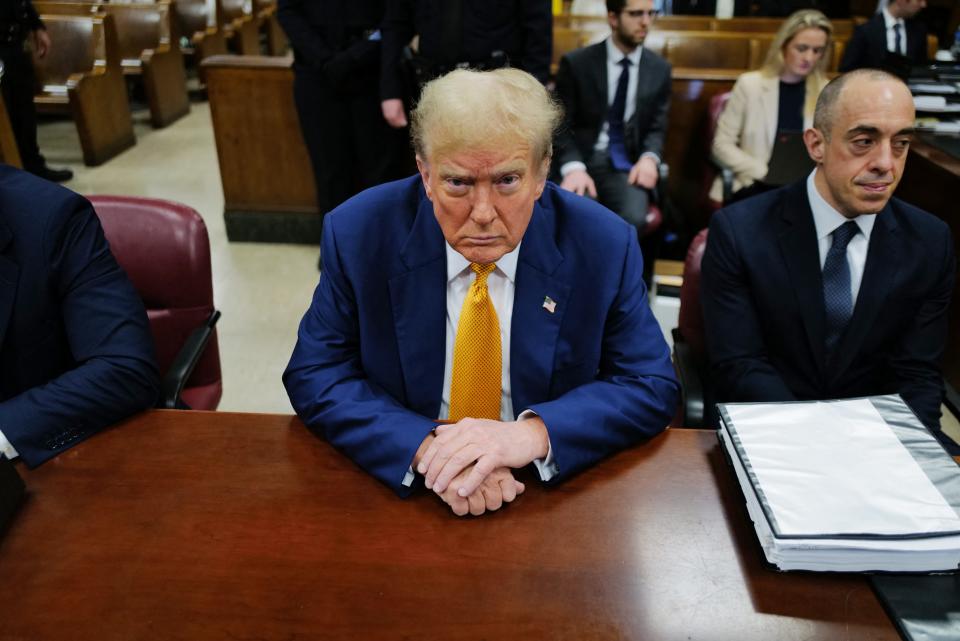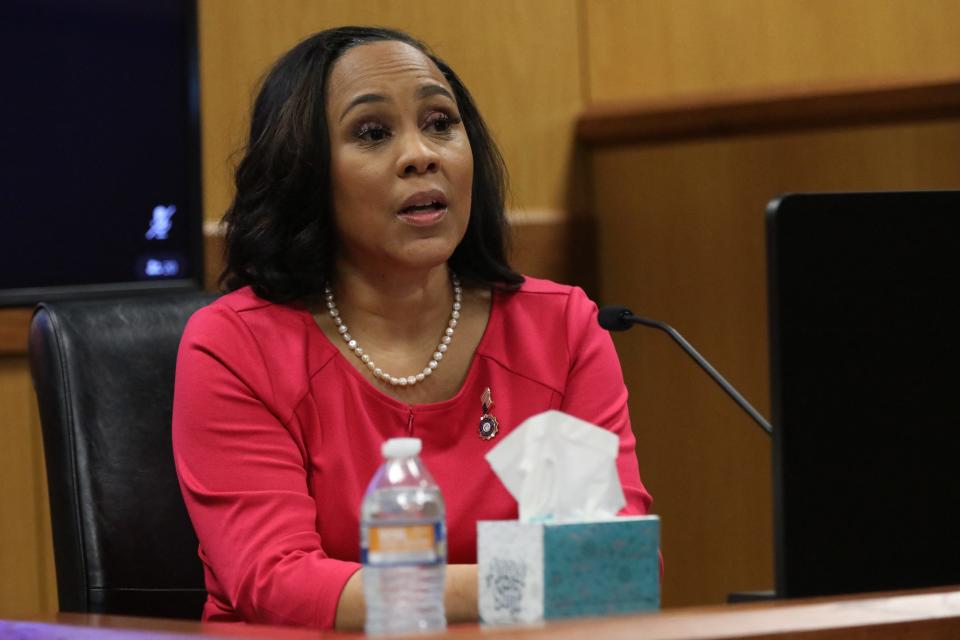Not long into the first day of Donald Trump’s historic criminal hush money trial, observers saw the former president’s chin fall to his chest as, eyes closed, his mouth went slack in an impromptu snooze at the defense table.
There were no cameras in the Manhattan courtroom to record Trump’s April 15 power nap. Audiences had to rely on the word of reporters who watched it happen. Nor were viewers − and voters − treated to a bracing 2016 recording, played in court on Thursday, of Trump and his former fixer Michael Cohen chewing over the $150,000 price tag for a former Playboy model’s silence.
That wouldn’t have been the case if Trump had been on trial in camera-friendly Georgia, where he faces state election racketeering charges. There, viewers were riveted to dramatic livestreamed hearings in February as Fulton County District Attorney Fani Willis fought to save her case against Trump from tawdry conflict-of-interest allegations.
A born showman, Donald Trump has thrived in front of the camera, especially during his 14-season run as the reality TV star of “The Apprentice.”
But the strict confines of an American courtroom − where a judge runs the show and the defendant is usually a silent onlooker − is another story.

What the public gets to see of the presumptive 2024 Republican nominee as he battles four criminal indictments stretching from New York to Palm Beach could have big impact on November’s election, but whether a televised trial would hurt or help the former president is an open question.
Right now, many legal veterans say Trump benefits from the absence of cameras at the trial in lower Manhattan: Details of the celebrity businessman’s purported affairs, his partnership with the National Enquirer supermarket tabloid and, yes, his mid-morning nap have all escaped turning into viral clips, GIFs and memes.
“Just think of the difference it would make in New York,” Court TV founder Steven Brill said. “You have Trump going out every day and saying the case has no basis and the witnesses are all liars.”
With cameras in the courtroom, viewers could see the evidence themselves, Brill said, blunting “Trump’s spin on it.”
Trump on Trial: ‘What have we done?’ Stormy Daniels’ attorney texted
Others don’t think cameras would hurt Trump’s electoral prospects − even the New York trial, which hinges on his attempts to pay off adult film star Stormy Daniels and former Playboy model Karen McDougal ahead of the 2016 election after both claimed to have slept with him.
“It would help him a great deal,” said New York political consultant George Arzt. “He would dictate rhetoric to his lawyers that would be more flamboyant than ever. I think it would delay the trial.”
No cameras? ‘I would be shocked’
The clearest view of Trump on trial will come from an Atlanta courtroom − if District Attorney Fani Willis’ election racketeering case survives ongoing challenges. “If the press is interested in a case in Georgia, they can have a camera there,” said Chris Timmons, a former Atlanta prosecutor.
Trump is also fighting federal indictments charging him with election interference in Washington, D.C., and hoarding classified documents in Florida. Cameras aren’t allowed in federal trials − and transcripts of those proceedings are only available for a fee.
In Manhattan − where Trump faces 34 charges of doctoring business records to hide a $130,000 hush money payment to Daniels − a small group of photographers are allowed into the courtroom to snap pictures of the famous defendant for one minute each morning, before the jury arrives.
“New York has clung to this very antiquated tradition of not having cameras in the courtroom,” former Manhattan prosecutor Diana Florence said. “If I was a layperson I would be shocked that you can’t have cameras in every courtroom across the country.”
A patchwork of rules governing state and federal courts provides differing degrees of access to Trump’s numerous legal cases. Last month, visitors to the Supreme Court’s website were able to hear live arguments over Trump’s claim that he’s immune from federal charges of trying to unlawfully overturn his 2020 election defeat.
But no images or audio were available earlier this year when a federal jury found Trump civilly liable for defaming former magazine writer E. Jean Carroll. Nor were there video cameras in the courtroom at Trump’s New York civil fraud trial earlier this year, which ended in a brutal $435.5 million verdict.
Trump on Trial: Donald Trump’s strange split-screen moment
Trump transcripts free to the public
In a nod to the historic nature of the hush money trial and sky-high public interest, New York’s court system has agreed to release daily transcripts of the first-ever prosecution of a former president. Previously, daily transcripts could only be obtained at great expense, usually by law firms and the press.
The move “changes the way we think about transparency,” white-collar defense attorney Ann Cortina Perry told USA TODAY. “There is a lot that can come out in a transcript.”
But that’s less transparency than in most of the country. More than 35 states routinely allow cameras in the courtroom. Georgia approved them in 2018. California has allowed cameras since 1984. New York has resisted the trend.
The OJ example
That’s thanks, in part, to the 1995 murder trial of Hollywood and NFL star O.J. Simpson in Los Angeles, some experts say. Simpson’s trial, a divisive cultural touchstone, featured “a lot of theatrics that wouldn’t have happened if cameras weren’t in the courtroom,” Florence said.
“Every day, on a daily basis, the defense would just fling stuff out there that had no basis in fact,” said Marcia Clark, a Simpson case prosecutor. “It can be really deleterious because it encourages lawyers to strut for the camera and say things that have no legal merit.”
“It’s possible the presence of the cameras impacted the trial, judge, the lawyers and the witnesses,” Carl Douglas, a member of Simpson’s defense team, told USA TODAY. “You know the old saying: The most dangerous place to be is between a trial lawyer and a camera. But the jurors were sequestered. They were insulated from the maelstrom.”
Trump on Trial: Freezing temps and colorful characters: Trump’s hush money trial from the inside
Clark said she’d heard after Simpson’s shock acquittal that the sequestered jurors, while barred from reading about the case or watching TV reports during the eight month trial, learned details of the press coverage during weekly visits from family members.
Clark and Douglas, former adversaries who both support the use of cameras, agreed that live broadcasts can nonetheless encourage some witnesses to inflate their testimony, while discouraging others who don’t want the limelight.
No one in the courtroom is sure to be immune from the camera’s influence, both said. “Some of these judges need to run for office,” Clark said. “The implications just go on and on and on.”
“I always fall back on the notion that this isn’t entertainment, it’s serious business,” said Christine Cornell, a courtroom sketch artist who’s covered the biggest criminal trials of the last 40 years − including the hush money case. “When it turns really public, the lawyers tend to be talking to a much bigger audience. It becomes a different animal.”
Trump on Trial: Meet the lawyers trying to keep the former out of prison in hush money case
Fani Willis burned by the camera
At livestreamed hearings in February over efforts by Trump and other defendants to dismiss the Georgia election conspiracy case over allegations the district attorney had hired her boyfriend as a special prosecutor, Willis surprised her team by making an emotional, combative appearance on the witness stand that later earned a rebuke from the judge.
“I’m a big fan of cameras in the courtroom,” Timmons, the former Atlanta prosecutor, told USA TODAY. “But that probably hurt her a little bit.”
Trump’s lawyers might face similar embarrassment if pushed by their powerful client to perform for the voters instead of the jury.


More: Judge Juan Merchan, presiding over Donald Trump’s NY criminal trial, has already ruled against him
Cameras at Trump’s trial would ‘cut both ways’
While New York has never allowed a trial to be broadcast, there are cameras in Judge Juan Merchan’s courtroom – one each aimed at the judge, the witness box, and the prosecution and defense tables, providing a live video feed to screens inside the chamber and to an overflow room of reporters. But members of the press are barred from recording or broadcasting what they see and hear.
The closed-circuit feed is “an all-seeing eye,” Cornell said. “It’s terrifying. The camera never leaves him, and I think that’s why he often sits with his eyes shut,” she said of Trump.
More: When it comes to Trump Supreme Court bid for immunity, his test case is Richard Nixon
But what if Trump’s morning nap on that first day of jury selection had been livestreamed? Would it have made a difference to voters seeing Trump − who is effusive about his own vitality and derides President Joe Biden as “Sleepy Joe” − dozing at his own trial?
“In this day and age of being able to manipulate images, some people would say it was a doctored video,” Florence said. “Ten or 20 years ago it would have been devastating.”
For Trump, a livesteamed trial would “cut both ways,” said Richard Emery, a veteran litigator and former member of New York state’s Commission on Public Integrity. “You would have all these clips of him in the courtroom in a criminal trial, and various witnesses saying things about him, the news media seizing on particular moments of the video. I think that would hurt him. “
On the other hand, courtrom cameras would give Trump his most prized possession: A megaphone. In January, Trump ignored the judge’s instructions at his civil fraud trial and instead raged against the state attorney general and the trial judge.
Televised proceedings, if they were permitted in New York, could create viral moments of Trumpian outrage to fire up the Republican base − especially if Trump were to testify in his own defense, experts said. But those electrifying scenes could alienate the most important audience of all.
“That’s a moment that would serve the interests of the campaign,” Emery said. “But it might backfire in the context of the trial and the jury’s decision.”
Contributing: Aysha Bagchi, USA TODAY
This article originally appeared on USA TODAY: Trump’s hush money case has an ‘all-seeing eye’ but no livestream


